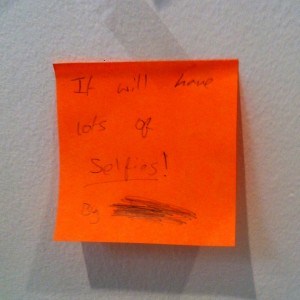Get Over Yourself-ie.
Walking through Liverpool’s Walker Art gallery last summer, I saw a display that baffled me to this day; titled “What Will the Art Gallery of the Future Look Like?” This display was interactive, taking up an entire wall with post-it notes revealing the public’s replies. And how did they respond? Was there an array of intellectual debate discussing the direction of art? Were there prophecies of art more “avant-garde” than Duchamp’s fountain? Not particularly. The one cohesive response that prevailed on a quarter of the post-it notes was that the art gallery of the future would display “lots of selfies”.
Now, after studying an art degree please note that I am not one to stick my nose up at modern art. I accepted Piero Manzoni’s “Artists Shit”, I took Andy Warhol’s experimental films in my stride. But this claim that today’s selfies could be an art form, and the fact that the majority of the public agreed with it, bothered me somewhat.
For those of you who have been living under a rock for the last couple of years, the common colloquialism “selfie” is defined by Oxford English Dictionary as “a photographic self-portrait; especially one taken with a smartphone or webcam and shared via social media”. Selfies have become one of the most significant cultural markers of our digitalised generation, the trend has also permeated into celebrity culture, as exemplified by the notorious Oscars selfie.
Although I don’t agree with the claim that such images could be classified as “art”, I understand the thought behind it – primarily because art has no fixed nature. Trying to rigidly define what art can and cannot be is, to quote the Sound of Music, like trying to catch a cloud and pin it down. Besides, I’m sure there have been worse things to grace a gallery than somebody’s filtered Instagram photo.
Generically speaking, art and selfies also share the objective of wanting to be seen. While art is primarily made for display, selfies are taken to be exhibited on social media. Furthermore, if art has one consistent trait, it’s that it is self-expressive of the artist. This can also apply to today’s selfies – what is more expressive than an image of the “artist”, taken by themselves? If Van Gogh’s painted self-portraits were classified as “art” and even photographic self-portraits such as Cindy Sherman’s merited gallery display, who’s to say Kim Kardashian with her half-naked selfies isn’t a modern master in our digital age?
However, the main difference is that selfie-takers do not seem to share artists’ nature of creativity. There’s very little imagination behind the selfie. Although both selfies and the generic work of art are created to be looked at, I believe there are different motives behind them. A conventional work of art is made largely for the audience; it can evoke emotion, contemplation or even discussion. The selfie however, is mainly valued by the number of likes it receives and therefore, evokes more emotion for the selfie-taker, through self-gratification, than the observer.
 Again, take Cindy Sherman’s work for example. While selfies are arguably similar in the fact that they are both photographic self-portraits, Sherman states her work is “trying to make other people recognise something of themselves rather than of her”. Art in general elevates more thinking than the standard selfie. I don’t know about you, but I have never studied somebody’s profile picture for longer than 20 seconds, if that. Thus, while art tends to be read as a text, the general selfie is just skimmed as we scroll through our news feeds. It is not particularly memorable.
Again, take Cindy Sherman’s work for example. While selfies are arguably similar in the fact that they are both photographic self-portraits, Sherman states her work is “trying to make other people recognise something of themselves rather than of her”. Art in general elevates more thinking than the standard selfie. I don’t know about you, but I have never studied somebody’s profile picture for longer than 20 seconds, if that. Thus, while art tends to be read as a text, the general selfie is just skimmed as we scroll through our news feeds. It is not particularly memorable.
Finally, while selfies are self-expressive it is difficult to assess how accurate a representation of the “self” this is. These images are taken and publicised to, quite literally, convey a desired image of oneself to the vastly public platform that is social media. The selfie therefore tends to be more of an idealised construction of oneself after carefully executed poses and strategic lighting. I believe a good piece of art expresses an interior self, whereas the selfie’s main focus is on exterior qualities that have been accentuated and often edited for the sake of a Facebook like.
Nevertheless, if there’s one thing my degree has taught me it’s that art is subjective. Chances are no one is ever going to agree on this matter and only time will tell whether selfies could be “art” in the future. As we all know, societal values are subject to change and what is nominally labelled “art” does not have to be categorised immediately, for example Van Gogh’s work wasn’t appreciated instantaneously. Maybe one day in the distant future, selfies could warrant more artistic gratitude and Kim Kardashian’s rear could be exhibited in galleries globally – I just hope it’s long after my time.
